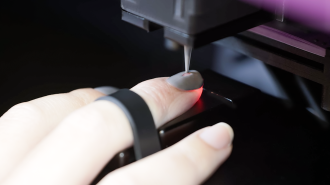For just $8, a robot at Target will paint your nails in under 10 minutes — but don’t expect the robot manicure to be the same as the ones at a salon.
The challenge: Getting a manicure at a salon can take anywhere from 30 minutes to 2 hours depending on the exact service.
The process requires you to interact with a manicurist, which might be awkward if you’re the kind of person who loathes small talk, and even the most basic option is likely to cost at least $20, plus a tip.
“We wanted … women to get a quality service, without having to spend a bunch of time and money.”
Renuka Apte
The robot manicure: San Francisco-based startup Clockwork has now trained an AI robot to paint fingernails. The service costs as little as $8 and takes fewer than 10 minutes.
“We wanted to create an accessible and affordable option for women to get a quality service, without having to spend a bunch of time and money,” Clockwork cofounder Renuka Apte told InStyle.
How it works: The tabletop robot is about the size and shape of a microwave. After inserting a small plastic cartridge containing their chosen color polish into the machine, the user places one of their hands on a hand rest inside it, with a single nail held in place by a small strap.
The robot’s 3D cameras take pictures of the nail and send them to its AI software. A nozzle then deposits the polish onto the nail in a single even coat.
“Our AI can identify edges within 0.3mm accuracy and tells the robot what is skin and what is nail,” Apte told Refinery29. “This is then sent to our sophisticated algorithms which determine how the nozzle should move to deposit nail polish in the right places.”
A few drops of a solution that helps the polish dry quickly are then added, and the user is instructed to put their next nail into the strap. Less than 10 minutes later, the robot manicure is complete.
Looking ahead: Clockwork’s robot manicures are already available at six Target locations, with the first appointment costing $8. Every appointment after that costs $9.99, though Clockwork does offer discounts if multiple manicures are purchased at once.
If you don’t live near one of those locations, you still might be able to get a robot manicure soon — Apte told Yahoo Finance more of the robots will be deployed in 2023.
“We’re pushing tens of thousands of partnership requests at this point,” she said. “Most of the contracts we’re signing today are for next year … We are backed up due to very strong demand.”
“Our AI can identify edges within 0.3mm accuracy and tells the robot what is skin and what is nail.”
Renuka Apte
The big picture: Clockwork’s robot manicure is about as basic as nail services get — the bot can’t even remove existing nail polish, let alone shape nail tips, trim cuticles, or apply acrylics. That makes it highly unlikely to take any significant business away from existing nail salons.
However, the robot’s speed and low cost could appeal to people who just want a quick cosmetic pick-me-up while on the go — no appointment or small talk required.
We’d love to hear from you! If you have a comment about this article or if you have a tip for a future Freethink story, please email us at [email protected].






